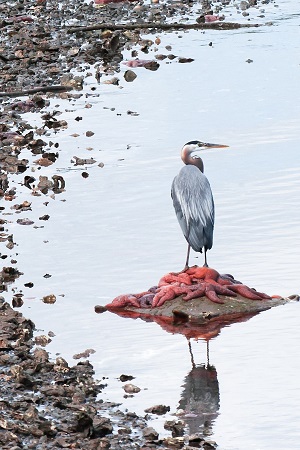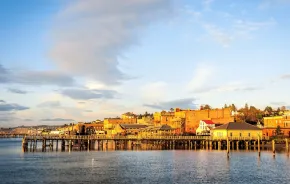
Photo:
Courtesy of Alderbrook Resort & Spa
Editor's note: This article was sponsored by Alderbrook Resort & Spa.
For many of us in the Pacific Northwest, the long, gray, monotonous period between the holidays and spring is marked by the urge to be someplace, any place, else. In the middle of a pandemic, hopping on a plane to warmer climes is not nearly as practical or appealing as it used to be. But the pandemic brings opportunities, too. While schools are operating remotely, a midweek getaway doesn’t have to mean missed school. And even though sunshine may not be in the forecast, nearby destinations like Hood Canal promise to boost mental and physical health for the whole family in a getaway that can complement all kinds of academic learning.
Exploring Hood Canal
Cindy Sund, director of marine services at Alderbrook Resort & Spa, wants everyone to know that Hood Canal is a terrible name for the place her family has lived since before Washington was a state. When she takes people out on sightseeing tours aboard the Lady Alderbrook, Sund is quick to explain that Hood Canal is not a canal at all. It is one of only two fjords in North America, formed like the fjords of Norway by glaciers millennia ago. It’s a quick geology lesson she likes to follow up with some history about the Europeans who explored the area and theories of how such an egregious misnomer came about. (A favorite theory involves lazy mapmaking; Sund likes to encourage families to read maps together and talk about the definitions of different types of geological features.)
“Hood Fjord” is a 63-mile-long inlet with steep sides that resist development, leading Mason County to dub the area “the wild side of Washington.” At night the only lights you’re likely to see are your own. The quiet will contribute to a good night’s rest in preparation for an adventurous day outdoors. From water to woodland, visiting Hood Canal is all about nature.
Wet and wild
Although the pandemic has closed most of the area’s sightseeing boat tours for now (chartered outings can sometimes be arranged), folks who go out kayaking or paddle boarding are likely to spot a lot of wildlife. You might see otters, harbor seals, sea lions, dolphins and rarely, orcas. Scuba divers routinely spot giant Pacific octopus.

“Hood Canal is probably one of the most pristine bodies of water we have here in the Northwest,” says Sund. But she explains that low dissolved oxygen is characteristic of fjords because they do not exchange water with the open ocean very quickly. That means people along the fjord have to reduce their footprint.
“It has a very delicate balance,” says Sund. In a bit of chemistry and water ecology that kids can understand, chemicals such as lawn fertilizer can lead to algal blooms that reduce oxygen in the water even more.
All ashore

You can study wildlife, especially birds such as eagles, blue herons and nighthawks (whose wings make a characteristic booming noise) from the shore.
The shoreline itself is another unique ecosystem. It doesn’t offer the soft sand and warm waters of a tropical beach (although your PNW babies might want to swim anyway). But Hood Canal is lined with oyster beds. In April, Alderbrook hosts guided shore walks; you can also visit a commercial farm to learn about oysters’ lifecycle and role in the ecosystem. In late winter and spring, you can get a license to gather your own shellfish at one of the public beaches. Make sure you have gloves and good boots when you’re exploring Hood Canal’s beaches — oyster shells are sharp! (Protect Fido’s feet, too!) Out of season, kids can relocate baby oysters toward the low tide line to help them grow.
Fishing is limited, but little kids can enjoy feeding them; baited, barbless fishing poles will attract minnows to the dock. In the fall, you might even get to see the salmon run.
Woodland life on the ‘wild side’
For more wildlife, hit the woodland trails (Alderbrook offers 7 miles of easy trails with interpretative signage; nearby state and national parks offer literally hundreds of miles more, at all skill levels). You might spot songbirds, owls, flying squirrels, deer and mountain goats.

Morgan Scherer, trails steward with Alderbrook, says coyotes and bobcats have been spotted, and rarely, “the butt-end of a bear.” Parents will be glad to know bears prefer to run away, but kids can keep an eye out for bear butts, animal tracks and scat, and the trails offer plenty of material for botanical study. Like the fjord, the forests around Hood Canal are unique.
“We are in the temperate rainforest. We have plants you wouldn’t find in other areas of the world,” says Scherer. There are only seven temperate rainforests in the world, and this is the only one in North America. The cedar, Doug fir and hemlock trees of the rainforest grow incredibly tall. Nurse logs and epiphytes such as mosses and licorice fern, are distinguishing features of this ecosystem.
Scherer regularly updates the Alderbrook blog with forest news such as the appearance of fall mushrooms and what’s in bloom. Ethnobotany is an easy way to get kids interested in plant identification. When Scherer leads hikes (available by reservation), he often points out edible wild berries for trailside snacking.
Life lessons
Familiarize yourself with water and trail safety. Be prepared with appropriate footwear and weather gear, and Scherer advises bringing a snack, which can make the difference for a good hike with energy and stamina. Don’t get attached to specific goals such as completing a trail.
“Come out with a positive attitude and an open mind. Life is so much better when we get outside,” says Scherer.
If you go:Alderbrook’s “2nd Semester Success” package includes afterschool snacks and activity kits developed by Hands On Children’s Museum, located in Olympia, Washington. If you or your child need to get work done during your stay, you can reserve a conference room. There are a handful of other lodgings in the area, and camping is available in the parks and private campgrounds (just be prepared for wet weather). |
|
Sponsored by: |

|











